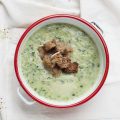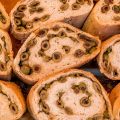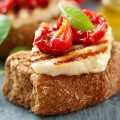Do you know the feeling when you have a picture of what something should be but life and reality take their own spin? It’s what happened to me this winter when I bought my first bag of einkorn wheat berries. I admit, I had some expectations about einkorn. I thought einkorn should at least have some of the characteristics of the modern wheat. Well, not really. The einkorn dough made out of freshly milled einkorn wheat flour is very sticky (similar to rye) and unless you plan to spend more time washing your hands than enjoying your bread, I advise you to touch the dough as less as possible. Let me share what I did to make einkorn sourdough bread.
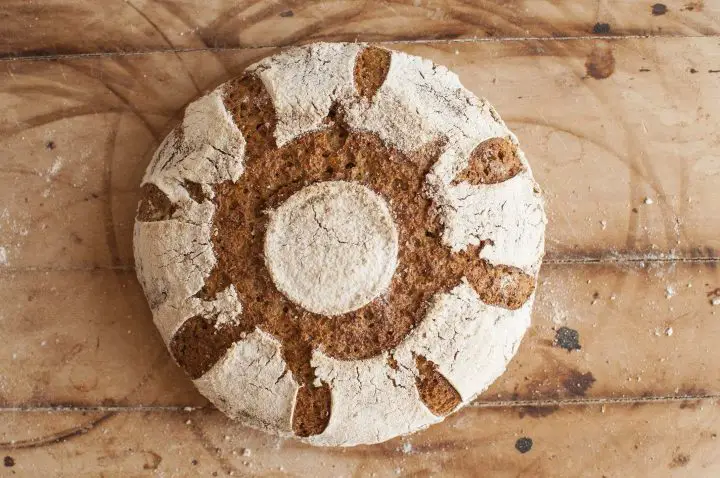
Table of Contents
Print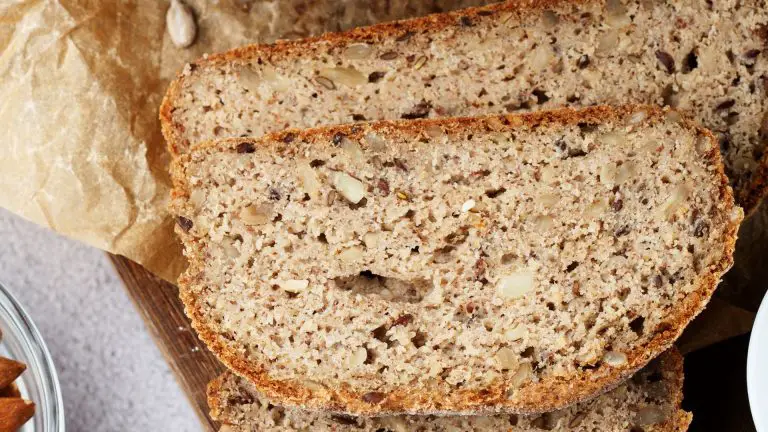
100% Whole Grain Einkorn Sourdough Bread Recipe
100% einkorn wheat sourdough bread is one of the most digestible breads you can make.
- Total Time: 14 hrs 40 mins
- Yield: 1 small/medium loaf 1x
Ingredients
- 400 g whole grain einkorn wheat flour
- 265 g water + 10 g water
- 100 g active rye sourdough starter (100% hydration)
- 8 g fine sea salt
Instructions
- In the evening, first mix 265 g of water, 100 g of active rye sourdough starter (I fed mine in the morning), and 400 g of whole grain einkorn wheat flour. Mix until all ingredients come together. Leave to rest (autolyse) for 30-60 minutes. The dough will be quite sticky. It helps to have wet or greased hands to handle the dough easier.
- After the rest you will notice the dough has relaxed a little bit. Add 8 g of salt and 10 g of water. If the dough fills stiff, add more water. Knead the dough for couple of minutes. To prevent sticking, wet your hands from time to time and use knuckles.
- Leave the dough in the bowl for another 2.5 hours at the room temperature (if it’s too cold, you might put the bowl in a slightly warm oven). Cover the bowl with a kitchen cloth to prevent the surface of the dough from drying out. In the meantime prepare the rising basket and flour it well. I lined my rising basket with a kitchen cloth and floured it with whole grain rye flour and white wheat flour.
- After 2.5 hours, the dough should look slightly risen and alive. Take the dough out on a lightly floured working surface. Pinch the ends of the dough together in the middle and transfer the dough to a rising basket. Work fast, as the dough will stick to your hands. Sprinkle some more flour on the top and cover it with the rest of the kitchen cloth. Put the basket in the fridge. Let the dough ferment until noticeably risen in volume and when the indent you make with your finger springs back slowly and not all the way up.
- This is how the dough looked in the morning. It has been fermenting for 11 hours. If you want the dough to rise slower, add less starter to the dough and if you want it to ferment faster, add more starter or leave the dough at the room temperature for half an hour after shaping it.
- When the dough is ready (or just before you think is ready), put the Dutch oven (or a baking stone) into oven and heat it to the maximum temperature of your oven for at least 30 minutes. In the meantime, keep the bread in the fridge to prevent overfermenting.
- When Dutch oven is preheated, take it out. Put a piece of parchment paper and a chopping board over the rising basket and turn everything upside down. Score the bread and transfer it to a Dutch oven.
- Bake the bread for 20 minutes with the lid on at 240°C/465F°F and 20-25 minutes with lid off at 230°C/445°F and until bread gets nice golden color.
Notes
- This bread was mixed in the evening, left to rise for 3 hours at the room temperature, shaped and then put in the fridge for 11 hours. It was baked in the morning of the following day.
- Prep Time: 14 hrs
- Cook Time: 40 mins
- Category: bread
- Cuisine: American, European
So, what is einkorn wheat?
Einkorn wheat (Triticum monococcum) is one of the first forms of wheat cultivated by humans. The word einkorn comes from German and it literally means one kernel. Einkorn has the single kernel per spikelet, or husks containing kernels on the head of the grain plant. For comparison, modern wheats have at least four kernels.
As spelt, einkorn is also a hulled wheat and thus requires an extra processing step which is called threshing and in which the hulls are removed. The hull has an important role: it can protect the grain from stray chemical contamination and insects making it an easier grain to grow organically.
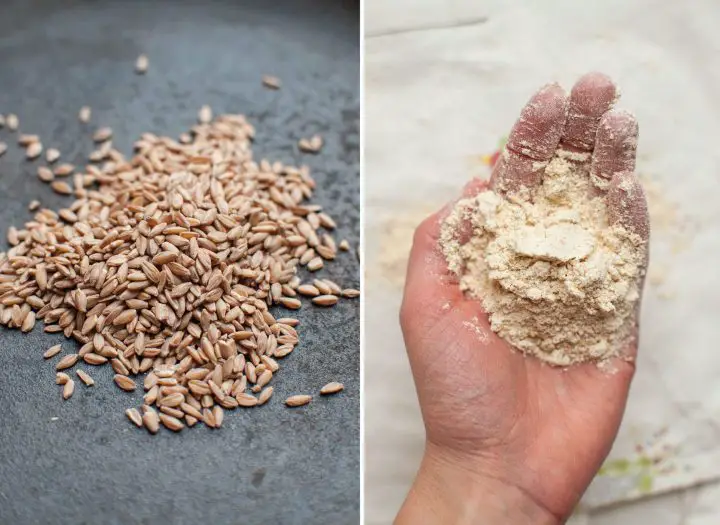
And why is einkorn wheat good for you?
- Being a diploid species, einkorn has 14 chromosomes while modern wheats have 42 and thus making it more friendly to our gut.
- Einkorn has less starch, namely less amylopectin (amylopectin + amylose = starch) which is responsible for blood sugar spike.
- Studies suggest that the gliadin protein (gliadin + glutenin = gluten) is not as toxic as with modern wheats making it easier to digest.
When tasting bread, I try to be aware of the feeling it leaves in my stomach. Without exaggeration, I found the einkorn bread to be the most digestible of all gluten grains sourdough breads. Try it for yourself and let me know how it worked for you. And now, let’s hop to the recipe.
Whole Grain Einkorn Sourdough Bread
Baking Schedule of the Einkorn Bread
This bread was mixed in the evening, left to rise for 3 hours at the room temperature, shaped and then put in the fridge for 11 hours. It was baked in the morning of the following day.
Ingredients for Einkorn Bread
Yields: 1 small to medium loaf
- 400 g whole grain einkorn wheat flour (I used freshly milled flour)
265 g water + 10 g water
100 g active rye sourdough starter (100% hydration)
8 g fine sea salt
Instructions
- In the evening, first mix 265 g of water, 100 g of active rye sourdough starter (I didn’t use einkorn sourdough starter. I fed mine in the morning), and 400 g of whole grain einkorn wheat flour. Mix until all ingredients come together. Leave to rest (autolyse) for 30-60 minutes. The dough will be quite sticky. It helps to have wet or greased hands to handle the dough easier.
- After the rest you will notice the dough has relaxed a little bit. Add 8 g of salt and 10 g of water. If the dough fills stiff, add more water. Knead the dough for couple of minutes. To prevent sticking, wet your hands from time to time and use knuckles.
- Leave the dough in the bowl for another 2.5 hours at the room temperature (if it’s too cold, you might put the bowl in a slightly warm oven). Cover the bowl with a kitchen cloth to prevent the surface of the dough from drying out. In the meantime prepare the rising basket and flour it well. I lined my rising basket with a kitchen cloth and floured it with whole grain rye flour and white wheat flour.
- After 2.5 hours, the dough should look slightly risen and alive. Take the dough out on a lightly floured working surface. Pinch the ends of the dough together in the middle and transfer the dough to a rising basket. Work fast, as the dough will stick to your hands. Sprinkle some more flour on the top and cover it with the rest of the kitchen cloth. Put the basket in the fridge. Let the dough ferment until noticeably risen in volume and when the indent you make with your finger springs back slowly and not all the way up.
This is how the dough looked in the morning. It has been fermenting for 11 hours.
If you want the dough to rise slower, add less starter to the dough and if you want it to ferment faster, add more starter or leave the dough at the room temperature for half an hour after shaping it.
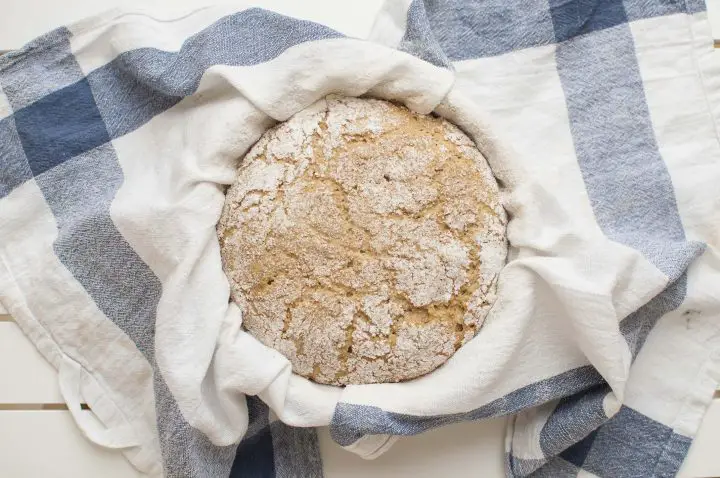
- When the dough is ready (or just before you think is ready), put the Dutch oven (or a baking stone) into oven and heat it to the maximum temperature of your oven for at least 30 minutes. In the meantime, keep the bread in the fridge to prevent overfermenting.
- When Dutch oven is preheated, take it out. Put a piece of parchment paper and a chopping board over the rising basket and turn everything upside down. Score the bread and transfer it to a dutch oven.
- Bake the bread for 20 minutes with the lid on at 240°C/465F°F and 20-25 minutes with lid off at 230°C/445°F and until bread gets nice golden color.
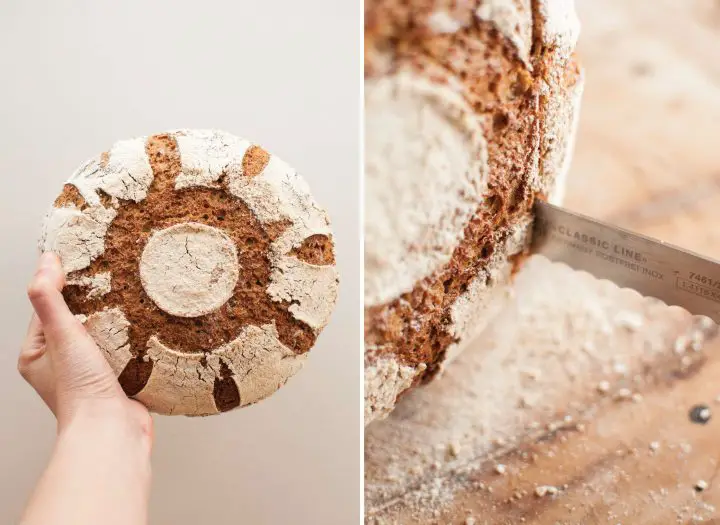
Cool on a cooling rack before cutting for at least 2-3 hours, otherwise the crumb can be gummy.
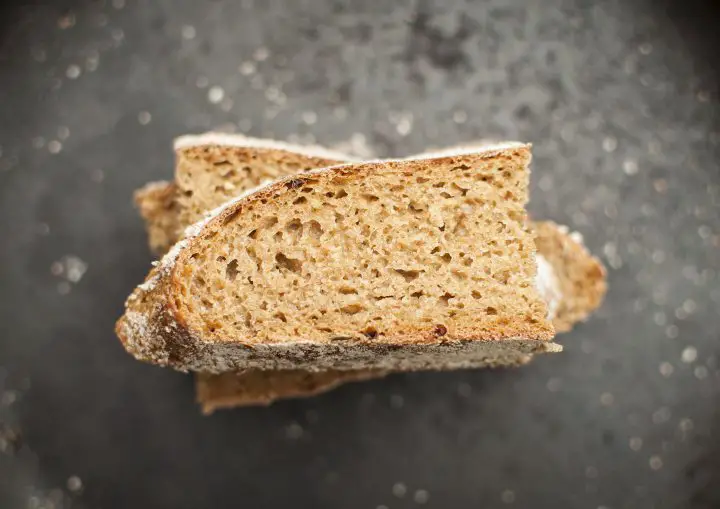
Einkorn is my favorite grain and it has learned me a lot. Especially to observe and take everything as it is and as it is unfolding in front of you, since this is all you have at that moment. Expectations are just illusions.
Have you tried baking with einkorn wheat? What was your experience? Tell me in a comment below.
Einkorn description reference found here.
Other grains for sourdough bread:
- Whole Wheat Sourdough Bread Recipe
- Sourdough Rye Bread Recipe with Homemade Yogurt
- Rustic Rye Sourdough Bread With Milk Kefir
Sourdough Einkorn Bread – FAQs
What is Einkorn sourdough?
Einkorn sourdough is a type of sourdough bread made using einkorn flour. Einkorn sourdough has a nutty flavor and a slightly sweet taste, which makes it a popular choice among bread enthusiasts. Einkorn sourdough is a delicious and healthy alternative to traditional bread, and its unique flavor and nutritional benefits make it a great choice for bread lovers who are looking for something new and different.
Can einkorn be used for sourdough?
Yes, einkorn can be used for making sourdough bread. Einkorn is an ancient variety of wheat that has a lower gluten content and a different protein structure compared to modern wheat. This can make it a bit more challenging to work with, but with some adjustments, it can produce a delicious sourdough bread. By using a blend of flours, allowing for longer fermentation times, adding more water, and being gentle when handling the dough, you can create a delicious sourdough bread using einkorn flour.
What are the benefits of Einkorn sourdough bread?
Whole grain einkorn flour is high in protein and contains more essential minerals, such as iron, potassium, and zinc, than modern wheat. It is also rich in carotenoids, which are antioxidants that can help protect against disease. The fermentation process of sourdough bread also breaks down the low gluten of einkorn further, making it even more digestible. Einkorn flour also has a lower glycemic index than modern wheat and most other bread flours.
Is einkorn good for sourdough starter?
Einkorn can be used to create a sourdough starter, but it may require a bit more patience and attention than a starter made with modern wheat flour. By using a blend of flours and allowing for a longer development time, you can create a successful einkorn sourdough starter that can be used to make delicious and nutritious bread.

